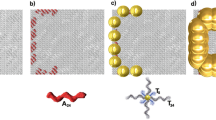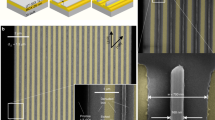Abstract
Single-crystal nanowire transistors and other nanowire-based devices could have applications in large-area and flexible electronics if conventional top-down fabrication techniques can be integrated with high-precision bottom-up nanowire assembly. Here, we extend dielectrophoretic nanowire assembly to achieve a 98.5% yield of single nanowires assembled over 16,000 patterned electrode sites with submicrometre alignment precision. The balancing of surface, hydrodynamic and dielectrophoretic forces makes the self-assembly process controllable, and a hydrodynamic force component makes it self-limiting. Our approach represents a methodology to quantify nanowire assembly, and makes single nanowire assembly possible over an area limited only by the ability to reproduce process conditions uniformly.
This is a preview of subscription content, access via your institution
Access options
Subscribe to this journal
Receive 12 print issues and online access
$259.00 per year
only $21.58 per issue
Buy this article
- Purchase on Springer Link
- Instant access to full article PDF
Prices may be subject to local taxes which are calculated during checkout





Similar content being viewed by others
Change history
09 July 2010
In the version of this Article originally published, Xiangfeng Duan and Samuel Martin were missing from the author list. Their names and affiliations have now been added to the HTML and PDF versions of the text. The supplementary information, acknowledgements, author contributions and competing financial interests statement have been amended.
References
Smith, P. A. et al. Electric-field assisted assembly and alignment of metallic nanowires. Appl. Phys. Lett. 77, 1399–1401 (2000).
Boote, J. J. & Evan, S. D. Dielectrophoretic manipulation and electrical characterization of gold nanowires. Nanotechnology 16, 1500–1505 (2005).
Hamers, R. J. et al. Electrically directed assembly and detection of nanowire bridges in aqueous media. Nanotechnology 17, S280–S286 (2006).
Liu, Y., Chung, J.-H., Liu, W. K. & Ruoff, R. S. Dielectric assembly of nanowires. J. Phys. Chem. B 110, 14098–14106 (2006).
Vijayaraghaven, A. et al. Ultra-large-scale directed assembly of single-walled carbon nanotube devices. Nano Lett. 7, 1556–1560 (2007).
Fan, D. L., Cammarata, R. C. & Chien, C. L. Precision transport and assembling of nanowires in suspension by electric fields. Appl. Phys. Lett. 92, 093115 (2008).
Raychaudhuri, S., Dayeh, S. A., Wang, D. & Yu, E. T. Precise semiconductor nanowire placement through dielectrophoresis. Nano Lett. 9, 2260–2266 (2009).
Oh, K., Chung, J.-H., Riley, J. J., Lui, Y. & Lui, W. K. Fluid flow-assisted dielectrophoretic assembly of nanowires. Langmuir 23, 11932–11940 (2007).
Duan, X. et al. High-performance thin-film transistors using semiconductor nanowires and nanoribbons. Nature 425, 274–278 (2003).
Cui, Y., Zhing, Z., Wang, D., Wang, W. & Lieber, C. M. High performance silicon nanowires field effect transistors. Nano Lett. 3, 149–152 (2003).
Tans, S. J., Verchueren R. M. & Dekker, C. Room temperature transistor based on a single carbon nanotube. Nature 393, 49–52 (1998).
Evoy, S. et al. Dielectrophoretic assembly and integration of nanowire devices with functional CMOS operating circuitry. Microelectron. Eng. 75, 31–42 (2004).
Cui, Y., Wei, Q. Q., Park, H. K. & Lieber, C. M. Nanowire nanosensors for highly sensitive and selective detection of biological and chemical species. Science 293, 1289–1292 (2001).
Li, M. et al. Bottom-up assembly of large-area nanowire resonator arrays. Nature Nanotech. 3, 88–92 (2008).
Morrow, T. J., Li, M., Kim, J., Mayer, T. S. & Keating, C. D. Programmed assembly of DNA-coated nanowire devices. Science 323, 352 (2009).
Brody, J. P., Yager, P., Goldstein, R. E. & Austin, R. H. Biotechnology at low Reynolds numbers. Biophys. J. 71, 3430–3441 (1996).
Pohl, H. A. Dielectrophoresis Ch. 4 (Cambridge Univ. Press, 1978).
Israelachvili, J. Intermolecular and Surface Forces Ch. 11,13 (Academic Press, 1991).
Hupka, L. et al. Particle–wafer interactions in semiaqueous silicon cleaning systems. Solid State Phenom. 145–146, 77–84 (2009).
Kanda, Y., Nakamura, T. & Higashitani, K. AFM studies of interaction forces between surfaces in alcohol–water solutions. Colloid Surf. A 139, 55–62 (1998).
Rosés, M., Ràfols, C. & Bosch, E. Autoprotolysis in aqueous organic solvent mixtures. Anal. Chem. 65, 2294–2299 (1993).
Morgan, H., Izquierdo, A. G., Bakewell, D. J., Green, N. G. & Ramos, A. The dielectrophoretic and travelling wave forces generated by interdigitated electrode arrays: analytical solution using Fourier series. J. Phys. D 34, 1553–1561 (2001).
Robbins, V. VLS growth of Si nanowires with in situ doping for MOS transistors. IEEE International Conference on Nanotechnology (NANO) 2009, Genoa, Italy, 26–30 July 2009.
Uppalapati, M., Huang, Y.-M., Jackson, T. N. & Hancock, W. O. Microtubule alignment and manipulation using AC electrokinetics. Small 4, 1371–1381 (2008).
Happel, J. & Brenner, H. Low Reynolds Number Hydrodynamics with Special Applications to Particulate Media (Prentice-Hall, 1965).
Westwater, J., Gosain, D. P. & Usui, S. Control of the size and position of silicon nanowires grown via the vapour–liquid–solid technique. Jpn J. Appl Phys. 36, 6204–6209 (1997).
Wagner, R. S. & Ellis, W. C. Vapor–liquid–solid mechanism of crystal growth. Appl. Phys. Lett. 4, 89–90 (1964).
Delgado, A. V., González-Caballero, F., Hunter, R. J., Koopal, L. K. & Lyklema, J. Measurement and interpretation of electrokinetic phenomena. J. Colloid Interface Sci. 309, 194–224 (2007).
Jan, D. & Raghavan, S. Electrokinetic characteristics of nitride wafers in aqueous solutions and their impact on particulate deposition. J. Electrochem. Soc. 141, 2465–2469 (1994).
Bousse, L. & Mostarshed, S. The zeta potential of silicon nitride thin films. J. Electroanal. Chem. 302, 269–274 (1991).
Acknowledgements
The authors thank V. Robbins, A. Fischer-Colbrie, W. Cao, J. Gibes, A. Suess and R. Perez for synthesizing and providing the nanowires used in this work and M. Bonin for fabricating substrates. R. Boehm wrote the image-processing software. The authors would like to acknowledge J. Hamilton for help with fabrication and design contributions to the deposition system, as well as helpful discussions. The authors would also like to thank P. Leon and W. Parce for helpful discussions.
Author information
Authors and Affiliations
Contributions
X.D. and S.M. designed and performed the initial work on the controlled dielectrophoretic assembly of nanowires at Nanosys, Inc. E.F. and D.S. conceived and designed the experiments reported in this manuscript. E.F. performed these experiments and analysed the data. O.G. contributed to the design and fabrication of the hardware. E.F. and D.S. co-wrote the paper.
Corresponding author
Ethics declarations
Competing interests
All authors have an ownership interest in Nanosys, Inc., and stand to benefit financially if this technology is commercially adopted.
Supplementary information
Supplementary information
Supplementary information (PDF 7339 kb)
Supplementary information
Supplementary movie 1 (MOV 19069 kb)
Supplementary information
Supplementary movie 2 (MOV 1206 kb)
Supplementary information
Supplementary movie 3 (MOV 2291 kb)
Rights and permissions
About this article
Cite this article
Freer, E., Grachev, O., Duan, X. et al. High-yield self-limiting single-nanowire assembly with dielectrophoresis. Nature Nanotech 5, 525–530 (2010). https://doi.org/10.1038/nnano.2010.106
Received:
Accepted:
Published:
Issue Date:
DOI: https://doi.org/10.1038/nnano.2010.106
This article is cited by
-
Concurrent self-assembly of RGB microLEDs for next-generation displays
Nature (2023)
-
Cryogenic multiplexing using selective area grown nanowires
Nature Communications (2023)
-
Predicting Supramolecular Structure from the Statistics of Individual Molecular Events
Mobile Networks and Applications (2023)
-
Toward monolithic growth integration of nanowire electronics in 3D architecture: a review
Science China Information Sciences (2023)
-
Mass transfer, detection and repair technologies in micro-LED displays
Science China Materials (2022)



